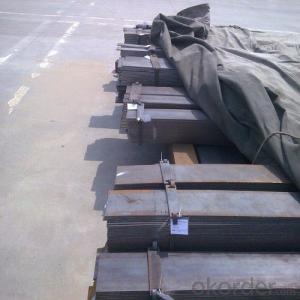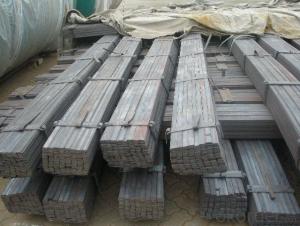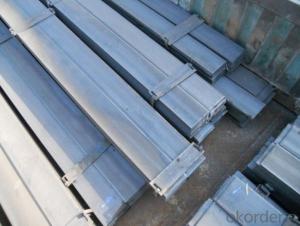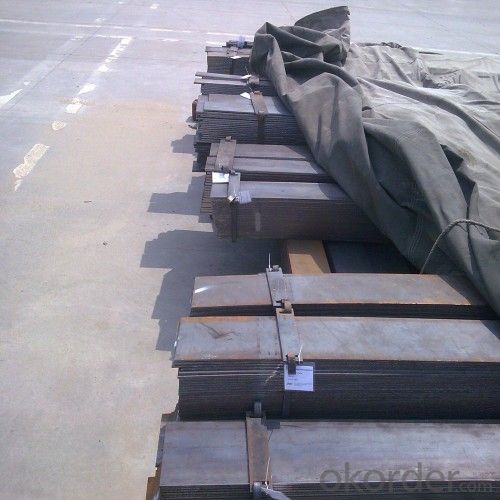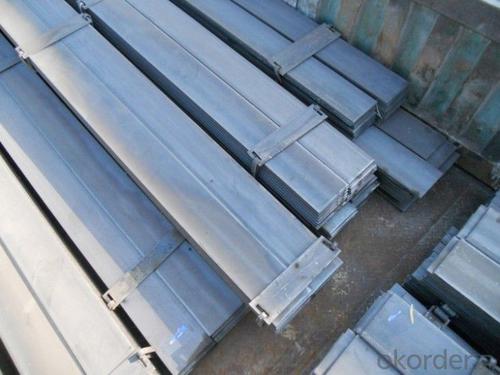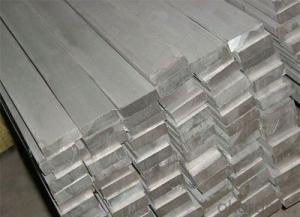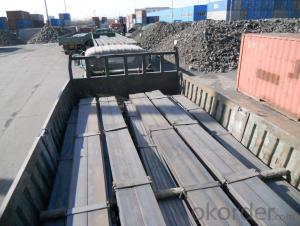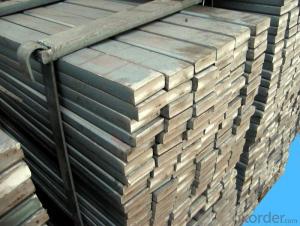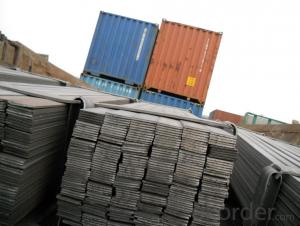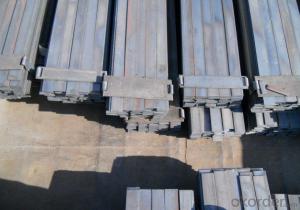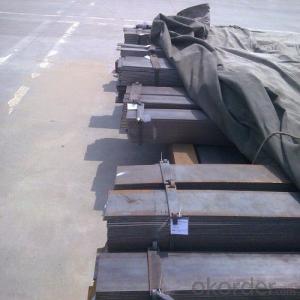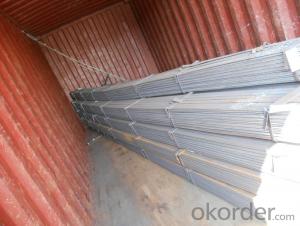Hot Rolled Flat Steel Bars with Material Grade Q235B
- Loading Port:
- Tianjin
- Payment Terms:
- TT OR LC
- Min Order Qty:
- 25 m.t.
- Supply Capability:
- 10000 m.t./month
OKorder Service Pledge
OKorder Financial Service
You Might Also Like
Product Description:
OKorder is offering high quality Hot Rolled Steel Flat bars at great prices with worldwide shipping. Our supplier is a world-class manufacturer of steel, with our products utilized the world over. OKorder annually supplies products to European, North American and Asian markets. We provide quotations within 24 hours of receiving an inquiry and guarantee competitive prices.
Product Applications:
Hot Rolled Steel Flat bars are ideal for structural applications and are widely used in the construction of buildings and bridges, and the manufacturing, petrochemical, and transportation industries.
Product Advantages:
OKorder's Steel Flat bars are durable, strong, and resist corrosion.
Main Product Features:
· Premium quality
· Prompt delivery & seaworthy packing (30 days after receiving deposit)
· Corrosion resistance
· Can be recycled and reused
· Mill test certification
· Professional Service
· Competitive pricing
Product Specifications:
Manufacture: Hot rolled
Grade: Q195 – 235
Certificates: ISO, SGS, BV, CIQ
Length: 6m – 12m, as per customer request
Packaging: Export packing, nude packing, bundled
Chemical composition of Q235
Alloy No | Grade | Element(%) | ||||
C | Mn | S | P | Si | ||
Q235 | B | 0.12—0.20 | 0.3—0.7 | ≤0.045 | ≤0.045 | ≤0.3 |
Physical properties of Q235
Alloy No | Grade | Yielding strength point(Mpa) | Tensile strength (Mpa) | Elongation after fracture(%) | ||||||
Thickness (mm) | Thickness (mm) | |||||||||
≤16 | >16--40 | >40--60 | >60--100 | ≤16 | >16--40 | >40--60 | >60--100 | |||
≥ | ≥ | |||||||||
Q235 | B | 235 | 225 | 215 | 205 | 375--500 | 26 | 25 | 24 | 23 |
FAQ:
Q1: Why buy Materials & Equipment from OKorder.com?
A1: All products offered by OKorder.com are carefully selected from China's most reliable manufacturing enterprises. Through its ISO certifications, OKorder.com adheres to the highest standards and a commitment to supply chain safety and customer satisfaction.
Q2: How do we guarantee the quality of our products?
A2: We have established an advanced quality management system which conducts strict quality tests at every step, from raw materials to the final product. At the same time, we provide extensive follow-up service assurances as required.
Q3: How soon can we receive the product after purchase?
A3: Within three days of placing an order, we will begin production. The specific shipping date is dependent upon international and government factors, but is typically 7 to 10 workdays.
Images:
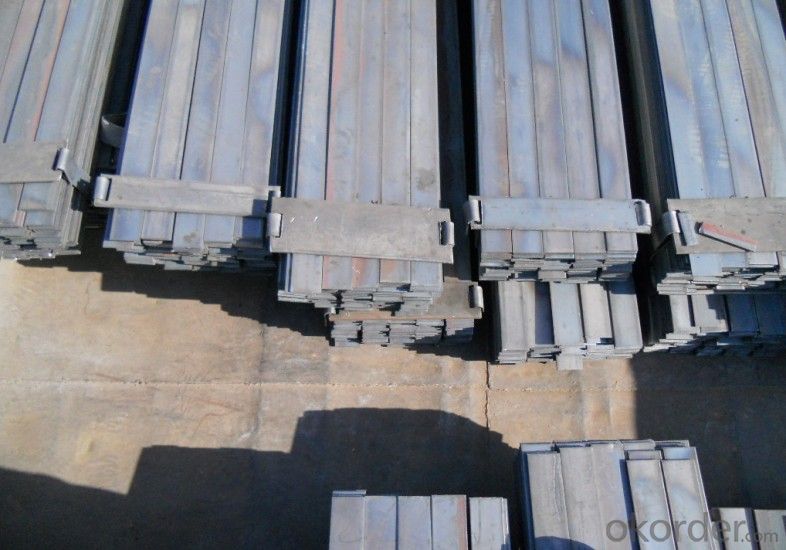
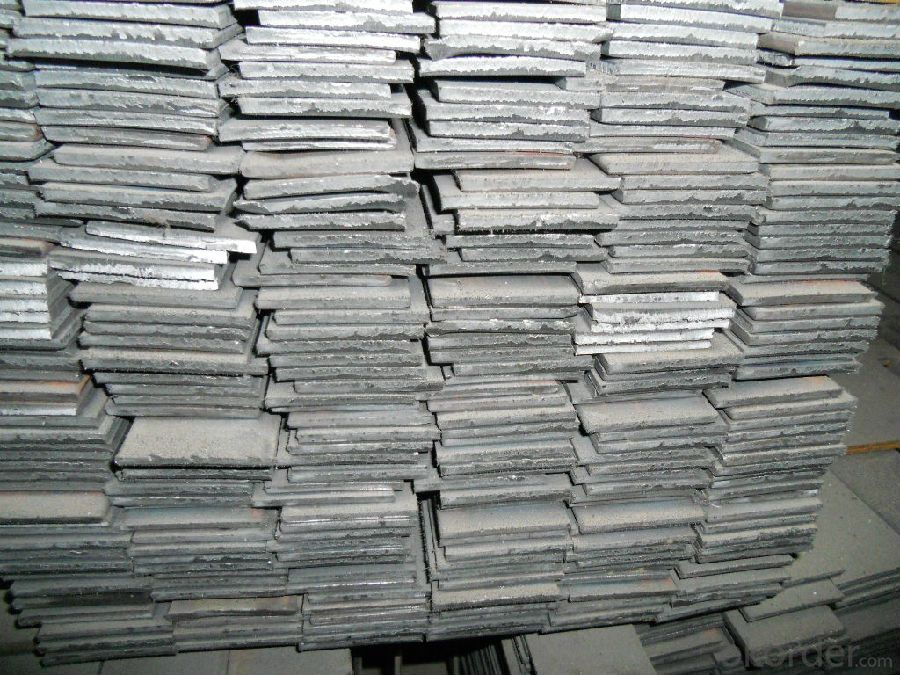
- Q: How do steel flat bars withstand heavy loads?
- Steel flat bars are able to withstand heavy loads due to their high strength and stiffness properties. The flat shape of the bar helps distribute the load evenly, while the steel material's inherent strength allows it to resist deformation and breakage under significant pressure. Additionally, steel is known for its excellent tensile strength, which enables it to handle heavy loads without bending or buckling.
- Q: What are the different types of surface defects in stainless steel flat bars?
- There are various types of surface defects that can be found in stainless steel flat bars, which can be categorized into several groups. Some common surface defects in stainless steel flat bars include the following: 1. Pitting: Pitting refers to the formation of small, localized corrosion spots on the surface of stainless steel flat bars. These spots appear as small holes or pits and are usually caused by exposure to aggressive environments such as solutions containing chloride or acidic substances. 2. Scaling: Scaling occurs when oxide layers form on the surface of stainless steel flat bars due to exposure to high temperatures. This results in a flaky or powdery deposit and can happen during processes like heat treatment or welding. 3. Corrosion: Corrosion is the gradual deterioration of the stainless steel surface due to chemical reactions with the environment. It can take various forms, including uniform corrosion, crevice corrosion, or stress corrosion cracking, depending on the specific conditions and environment. 4. Scratches: Scratches are physical marks on the surface of stainless steel flat bars caused by abrasive contact or mechanical damage. They can vary in depth and severity, and if not addressed properly, they can create localized areas of stress concentration and potential sites for further corrosion. 5. Roll marks: Roll marks are imperfections on the surface of stainless steel flat bars that occur during the manufacturing process. They appear as irregular patterns or lines on the surface and are typically caused by the rolling or finishing equipment used in production. 6. Discoloration: Discoloration refers to changes in the appearance or color of the stainless steel flat bar surface. It can be caused by exposure to high temperatures, chemical reactions, or improper cleaning methods. Discoloration can manifest as light or dark patches, streaks, or a rainbow-like effect known as "heat tint" in cases of overheating during welding. It is important to emphasize that surface defects in stainless steel flat bars not only affect their visual appeal but also compromise their corrosion resistance, mechanical properties, and overall performance. Therefore, it is vital to promptly identify, assess, and address any surface defects to ensure the longevity and reliability of stainless steel flat bars.
- Q: Friction coefficient of steel pipe and flat steel on roller table!
- Section steel is one of the four major steel products (plate, tube, mould, wire). According to the section shape, the section steel is divided into simple section steel and complex section steel (Xing Gang). the formerRefers to the steel, round steel, flat steel, angle steel, six angle steel; the latter refers to the I-beam, channel steel, steel, steel, steel frame bending etc..
- Q: What is the negative deviation allowed by the national standard for galvanized flat steel of 40*4?
- 40 is the width of the section steel, 4 is the thickness of the steel, and the unit is mm.Flat, refers to the width 12-300mm, thickness 4-60mm, cross section is rectangular in shape and with a blunt edge of steel. Flat steel can be finished steel, or can be used as the blank of welded pipe and thin slab for laminated sheet rolling.
- Q: What are the different standards or specifications for steel flat bars?
- Steel flat bars are subject to various standards and specifications that define their specific requirements and characteristics. Some commonly used standards include: 1. ASTM A36/A36M: This standard pertains to carbon structural steel shapes, plates, and bars of structural quality. It covers their use in construction projects involving bridges, buildings, and general structural purposes. The standard details the chemical composition, mechanical properties, and other specifications for steel flat bars. 2. ASTM A572/A572M: This standard addresses high-strength low-alloy columbium-vanadium structural steel shapes, plates, sheet piling, and bars. It applies to bolted, welded, and riveted structures. The standard specifies the chemical composition, mechanical properties, and other relevant characteristics for steel flat bars. 3. ASTM A1011/A1011M: This standard encompasses hot-rolled carbon steel sheets, strips, and bars for general applications. It includes specifications for steel flat bars, such as the chemical composition, mechanical properties, and other necessary requirements. 4. JIS G3101: This Japanese standard establishes general requirements for hot-rolled steel plates, sheets, and strips used in general structural applications. It provides guidelines for steel flat bars, including the chemical composition, mechanical properties, and other significant specifications. 5. EN 10025: This European standard defines the technical delivery conditions for structural steel products, including steel flat bars. It outlines the requirements for steel grades, chemical composition, mechanical properties, and other relevant characteristics. These examples merely scratch the surface of the numerous standards and specifications available for steel flat bars. The choice of standard depends on the specific application and project requirements, ensuring that the steel flat bars adhere to the desired quality and performance standards.
- Q: How do steel flat bars perform in high-temperature oxidation conditions?
- Steel flat bars are known to perform well in conditions of high-temperature oxidation. Their resistance to oxidation, especially in the presence of oxygen, is well-documented. At elevated temperatures, a protective oxide layer forms on the surface of the steel flat bar. This layer is primarily composed of iron oxide and acts as a barrier to prevent further oxidation and corrosion, thereby preserving the integrity of the steel in high-temperature environments. Moreover, the composition of the steel is a determining factor in its performance under high-temperature oxidation conditions. Steel grades containing higher levels of chromium, such as stainless steel, exhibit even greater resistance to oxidation. This is due to the formation of a stable and protective chromium oxide layer on the surface, which acts as an additional barrier against oxidation. As a result, steel flat bars with higher chromium content demonstrate improved performance in high-temperature oxidation conditions. Nevertheless, it should be noted that prolonged exposure to extremely high temperatures or harsh oxidizing environments, as encountered in certain industrial processes, can still cause some degree of oxidation and degradation. Therefore, it is advisable to carefully consider the specific operating conditions and seek guidance from experts or engineers in order to select the appropriate steel grade or apply additional protective coatings, if necessary, to ensure optimal performance in high-temperature oxidation conditions.
- Q: What is the difference between a steel flat bar and a steel hex bar?
- The main difference between a steel flat bar and a steel hex bar lies in their shape and design. A steel flat bar, as the name suggests, is a long, rectangular-shaped bar with a flat surface on all sides. It has a uniform thickness throughout its length and is typically used for structural applications, such as supports, braces, and framing. The flat surface allows for easy fastening or welding to other components. On the other hand, a steel hex bar is a bar with six equal sides, forming a hexagonal shape. This unique design provides increased strength and stability compared to a flat bar. The hexagonal shape also offers better grip and torque resistance, making it suitable for applications that require high tensile strength, such as machinery, tools, and hardware components. In terms of versatility, a steel flat bar can be easily manipulated, cut, or bent to fit various shapes and sizes, making it a more flexible option for different projects. Conversely, a steel hex bar is more rigid and less malleable due to its six-sided structure, limiting its adaptability but enhancing its strength. In summary, while both steel flat bars and steel hex bars are made from the same material, their distinct shapes and designs make them suitable for different applications. The flat bar is commonly used for structural purposes, while the hex bar is preferred for applications requiring higher strength and torque resistance.
- Q: How are steel flat bars stored or transported?
- Steel flat bars are typically stored in bundles or stacks in warehouses or storage yards. They are often bundled together using steel straps or wires to prevent them from shifting during transportation. When transported, flat bars are loaded onto trucks or trailers and secured with straps or chains to ensure they remain in place during transit.
- Q: What are the weight and load-bearing capacities of different steel flat bar sizes?
- Steel flat bars can have varying weight and load-bearing capacities depending on their size. Generally, the larger the flat bar, the greater its weight and load-bearing capacity. Below are some common sizes of steel flat bars and their approximate weight and load-bearing capacities: 1. For a thin flat bar that is 1/8 inch thick, it is typically used for lighter applications. Its weight can range from around 0.42 pounds per foot, and its load-bearing capacity is approximately 200 pounds per foot. 2. If the flat bar is slightly thicker at 1/4 inch, it can handle heavier loads. It typically weighs around 0.85 pounds per foot and has a load-bearing capacity of about 400 pounds per foot. 3. A thicker option is the 3/8 inch steel flat bar, which can support even greater loads. Its weight can range from around 1.27 pounds per foot, and its load-bearing capacity is approximately 600 pounds per foot. 4. Significantly thicker, the 1/2 inch steel flat bar is commonly used for heavy-duty applications. It weighs around 1.7 pounds per foot and has a load-bearing capacity of about 800 pounds per foot. 5. For extremely heavy loads, the 1 inch thick steel flat bar is suitable. It typically weighs around 3.4 pounds per foot and has a load-bearing capacity of approximately 1600 pounds per foot. It is important to note that these weight and load-bearing capacities are approximate and can vary based on the grade and quality of the steel used. Other factors such as the length and support conditions of the flat bar should also be considered when determining its maximum load-bearing capacity. It is advisable to consult professional engineers or refer to load tables provided by steel manufacturers for accurate and specific information on the weight and load-bearing capacities of steel flat bars.
- Q: Are steel flat bars resistant to fire?
- Generally, steel flat bars are resistant to fire. Steel, being a non-combustible material, does not burn or aid in the spread of fire. Due to its high melting point and excellent heat resistance, steel is highly resistant to fire. As a result, steel flat bars are commonly used in construction, manufacturing, and industrial settings where fire resistance is necessary. However, it is important to remember that while steel itself is fire-resistant, other materials attached to or surrounding the steel bars may not be. Therefore, it is crucial to consider the entire system and ensure that all components are fire-resistant to provide maximum fire protection.
Send your message to us
Hot Rolled Flat Steel Bars with Material Grade Q235B
- Loading Port:
- Tianjin
- Payment Terms:
- TT OR LC
- Min Order Qty:
- 25 m.t.
- Supply Capability:
- 10000 m.t./month
OKorder Service Pledge
OKorder Financial Service
Similar products
Hot products
Hot Searches
Related keywords
